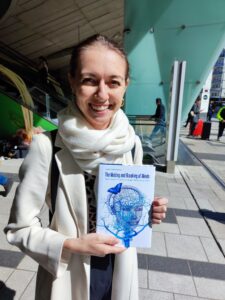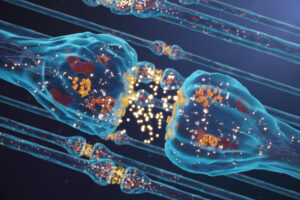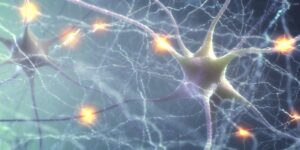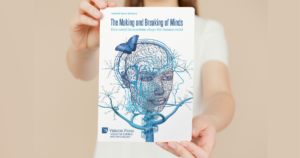Mein Forschungsschwerpunkt befasst sich mit den konstruktiven & destruktiven Wirkkräften, die neuroplastische Prozesse steuern.
“THE MAKING AND BREAKING OF MINDS: How social interactions shape the human mind” (Vernon Press) is concerned with the formative role that the social environment plays in healthy brain development in humans, especially during infancy, childhood, and adolescence. Underlying the cognitive development is the process of neuroplasticity. This leads to the brain’s remarkable capacity of reorganizing itself, flexibly adjusting to fluctuating environmental conditions.
In this interview with author Dr. Isabella Sarto-Jackson, neuroscientist at the KLI, we will talk about how the socialaspect of the brain, coupled with its neuroplasticity, has been left out of the reductive, molecular approaches of neuroscience, with wide-ranging consequences for how society understands and treats the youth.
Lynn Chiu: Isabella, let’s get straight to the core of your thesis. What is the specific issue you’re seeking to shed new light on and why is it important?
 Isabella: Neuroplasticity is the basis for wide-ranging learning and memory processes. The exceptional malleability of the developing brain leaves it highly vulnerable to negative impact from the surroundings. Abusive or neglecting social environments as well as socioeconomic deprivation can compromise cognitive development, emotional processing, self-perception, and executive brain functions. The neurophysiological changes entailed impair emotional regulation, lead to heightened anxiety, and afflict attachment and the formation of social bonds. Neuroplastic changes alter the neurobiological and biochemical makeup and cause people to live in an emotionally relabeled world in which the evaluation of social cues can be biased. In addition, detrimental neurophysiological consequences are not limited to the traumatized individual, but are often transmitted to subsequent generations through a process of social niche construction. Often called “transgenerational trauma,” this phenomenon has been described for children and grandchildren of Holocaust survivors, of survivors of Native American genocide, or of slavery. I am focused on the “making and breaking forces” that drive neuroplastic processes. These are forces mediated by parents, alloparents, peers, and our socioeconomic niche.
Isabella: Neuroplasticity is the basis for wide-ranging learning and memory processes. The exceptional malleability of the developing brain leaves it highly vulnerable to negative impact from the surroundings. Abusive or neglecting social environments as well as socioeconomic deprivation can compromise cognitive development, emotional processing, self-perception, and executive brain functions. The neurophysiological changes entailed impair emotional regulation, lead to heightened anxiety, and afflict attachment and the formation of social bonds. Neuroplastic changes alter the neurobiological and biochemical makeup and cause people to live in an emotionally relabeled world in which the evaluation of social cues can be biased. In addition, detrimental neurophysiological consequences are not limited to the traumatized individual, but are often transmitted to subsequent generations through a process of social niche construction. Often called “transgenerational trauma,” this phenomenon has been described for children and grandchildren of Holocaust survivors, of survivors of Native American genocide, or of slavery. I am focused on the “making and breaking forces” that drive neuroplastic processes. These are forces mediated by parents, alloparents, peers, and our socioeconomic niche.
Lynn: There are a lot of rich, interconnected concepts to unpack here! Can you tell us how you reached this point, that is, how you encountered these issues, found the connections, and brought them all together?
Isabella: My scientific training was in fields that are usually considered to be reductionist (molecular biology, genetics, neurobiochemistry). About 13 years ago, I extended my research focus to cognitive science. One of the main reasons for this step was to tackle the explanatory gap between the molecular dimensions of brain processes and those on the organismal level (in humans: the behavioral as well as psychological dimensions).
Neuroscience is per se very interdisciplinary; but because of the complexity of the brain, “big” questions like “what is cognition,” “how does cognition develop ontogenetically,” “what is/are the phylogenetic origin/s of cognition” require an interdisciplinary effort. For ontogeny and the developing brain, neuroplasticity is the keyword. Understanding the complexities of human behavioral expression is an extremely difficult undertaking that begins at the molecular level and ends at the human population level. Neuroscientists and social scientists are in studying how human neurobiology and behavior are interactive, self-organizing, and emergent. There is incontrovertible neurobiological evidence that networks are dynamically generated and not genetically predetermined, i.e., behavioral expressions are derived from experience, neuroplasticity, development, and context individual and cultural. The notion that human behavior propensities are the product of predetermined genetic neural modules as advocated by proponents of Sociobiology and EvoPsy needs to be challenged.
At the KLI, I was exposed to novel concepts from the philosophy of science as well as from EvoDevo (evolutionary developmental biology). These new vistas certainly contributed to how I formulated my questions and looked into research findings. Ultimately, the reason why I wrote the book was because of interactions with experts from neighboring fields. Especially scholars from psychology and social work were keen on learning more on what philosophy of neuroscience and EvoDevo can contribute to their own field of expertise. Scholars with whom I interacted pointed out that conceptual frameworks in their home disciplines still drew on old concepts that now have been challenged. E.g., genetic determinism; the molecular basis of psychopathologies; the mechanistic and biostatistic worldview of how the human body and brain work (e.g., what we consider to be normal functioning); intergenerational transmission of knowledge and behavior; the massive modularity hypothesis, etc.
In a nutshell, the book I wanted to write did not aim at formulating a completely new thesis, but connecting the strands of neuroscience with EvoDevo and social education work.
Lynn: Can you elaborate a little more about the conceptual terrain around neuroplasticity? What is the current status of the so-called Nature versus Nurture debate in both neuro- and cognitive science and how does an evo-devo approach fit in?
Isabella: The nature versus nurture debate has been guided by unproductive dogmas for many years. On one hand, there is genetic determinism rooted in preformationist thinking (see Lewontin), the notion of massive modularity of the human brain, and the assumption that behavior is a linear extension of brain processes. On the other hand, human behavior and social institutions have been explained from a perspective that views the human brain as a black box and draws from simple reward/punishment concepts of behaviorism.
In the last two decades, the nature vs. nurture debate that dominated opposing theoretical stances has moved from either/or arguments to complex issues like the emergent and self-organizing biological and developmental interactions (e.g., E.F. Keller), or the framework of a connectionist perspective that merges development and neurobiology (e.g., L. Feldman Barrett; A. Karmiloff-Smith). Also, research methodology and data acquisition has become more interdisciplinary.
For example, two subfields that have undergone significant restructuring in the last two decades are Psychological Development and Developmental Neurobiology, shifting to more inclusive studies relating developmental and neurobiological processes (e.g., language development and neuroplasticity, brain development and the role of gender, etc.). There is increasing agreement that developmental and neurobiological processes must be understood interactively if the Development Sciences are to achieve evidence-based explanations of cause and effect. What has been missing from these research endeavors is the importance of processes that act on longer time scales, i.e., evolutionary processes and why some social processes (even allegedly maladaptive ones) that strongly influence cognitive development are maintained over generations.
While the Modern Synthesis would contribute little to the aforementioned research endeavors, EvoDevo, especially concepts that fall under the umbrella of the Extended Synthesis like niche construction and inclusive inheritance, can contribute crucial information for the incorporation of environmental, cultural, and social aspects to the individual context. Therefore, by looking at brain development under the lens of evolutionary processes, we gain new insights into inheritance of cognitive processes mediated by social experiences. Examples range from collaboration, emotional bonding, cognitive skills (like language, “intelligence”, etc.), social preferences, and other cultural dimensions that can be shaped by means of sociocultural niches and processes of scaffolding.
Lynn: It seems to me that your book is filling two gaps. The first gap is between theory and data in neuroscience, which you seek to bridge through an Evo-Devo approach, with great sensitivity to the philosophy and history of science. But it also fills the gap between so-called “pure science” and its “applications.” What were the pre-existing theoretical basis of education and youth support, if any? What are the consequences of the work you’re putting forward?
Isabella: In the 1960s, models based on biological inheritance were replaced by psychological-pedagogical approaches. The focus was no longer exclusively the individual, but also the social environment. Nonetheless, behavioral deviance was seen as a symptom of lack of adaptation to certain social environments. Children or people in general acted out as regressive defense mechanisms triggered by antisocial feelings, low frustration tolerance, and defiance (and thus considered adaptation disorders or psychopathologies). In the 1970s, socialization theory took root and emphasis was given to the person’s social history. Rather than maladaptation, behavioral deviances were considered constructive problem-solving strategies as a reaction to a toxic environment. This conceptual shift moved the thinking away from linear to circular causality. Eventually, in the last years, systems theoretical approaches have been introduced in social work. The latter closely looks at the interrelationships of all family members and its dynamics, including developmental lifecycle challenges and usually argues against behavioral pathologies or maladaptation. The latter has significant consequences in terms of positive interventions (alloparenting, social support networks, scaffolding, psychoeducation).
I think, the book will be a valuable resource for academics from social education, pedagogy, cognitive science, neuroscience, as well as professionals in the fields of social work, pedagogy, education, child welfare. I advocate for bold measures and responsible stewardship to combat child abuse, maltreatment, and child poverty. In the last chapter of the book, I offer suggestions based on current state-of-the-art methods derived from psychology, psychotherapy, and child welfare work on what can we do as a society and what can I do as parents, peers, and alloparents.
Lynn: Speaking of child abuse, poverty, and maltreatment, your book mentioned some horrifying historical events in science and public policy. Can you give us an example? How are they related to the conceptual approach we take to brain development?
Unfortunately, science and public policy have not always been in the best interest of its subjects. In the book I refer to historical or recent examples of individuals who suffered from maltreatment, abuse, or other adverse experiences.
One of the examples I used is Robert King who was convicted of prison murders and was held in solitary confinement for 29 years. As a consequence of his social isolation and sensory deprivation, he suffers from long-lasting effects on the brain. His memory is significantly impaired and he can no longer navigate, not even in familiar places due to a loss of hippocampal plasticity. He has been unable to recognize faces because of an atrophy of the fusiform gyrus. Luckily, King’s atrophied brain areas seemed to have undergone neuroplasticity, as he slowly has regained his ability to recognize faces.
For a long time, isolation, solitary confinement, and social segregation was considered an appropriate corrective method for delinquents. Recent studies have shown the devastating psychological and neuroanatomical consequences. Practice of solitary confinement has been widely condemned by health professionals, social workers, and human rights organizations. Some states in the U.S. have now passed legislation that significantly limit solitary confinement of mentally ill and juvenile offenders.

Lynn: Were you in touch with organizations or people working with marginalized youth? How did these connections impact your work?
Isabella: In the last few years, I have been collaborating with people who deal with youth at risk (like SOS Kinderdorf, Pro Juventute, Protection against Violence Center, etc.). The practical insights I gained from these practitioners helped me to grasp the dimension and seriousness of the societal challenges we are facing when trying to provide rewarding perspectives for youth at risk.
Let me give you an example: in Austria, adolescents have to leave the care facility when they are 18 years old. These young people usually have a biography of frequently changing care institutions and caregivers and their lives are often characterized by social thinning. Neuroscience has given us good evidence that the human brain, especially the prefrontal cortex that is involved in executive functions, still develops until the mid/late twenties. Child psychologists and therapist corroborate these neuroscientific findings using behavioral studies. As a consequence, care-leavers who struggle with social deprivation on one hand and are in the process of maturation of their planning and decision-making skills on the other hand, may have significantly less chances to become successful in life. But we are not only failing the individual, but society at large as we might lock out a big pool of talents and potential.
The question is now: do policy makers use these scientific insights?
It is of course a slow process, but I think that things are moving in the right direction. Two years ago, representatives of the Municipal Department 11 of Vienna (child and youth welfare) initiated a debate about extending the possibility that young people in out-of-home care can stay in care institutions until they are 21. 3 federal provinces have already made legislative changes, Vienna is still lagging behind, though:
https://kja.at/careday21-gleiche-chancen-fuer-care-leaver/
Another issue, I have recently been involved in, is the “valorization” of elementary pedagogy. From a neuroscientific point of view, it is undisputed that the most significant neuroplastic changes occur in early childhood. Neuroplasticity underlies learning processes and clearly these processes are particularly extensive in early childhood. Yet, in the public eye (at least in Austria), elementary pedagogues who are crucially involved in supporting cognitive development in young children are still considered to be “child minders” rather than teachers. An initiative has started to change this perception, acknowledge the educational work kindergarten teachers do, and provide conditions that kindergarten teachers can adequately support children in their cognitive development.
https://www.neboe.at/elementarbildung-at
Lynn: Isabella, this is very inspirational. You’re walking the talk and bringing multiple teams and disciplines with you. Can you tell us how we can follow your footsteps to set up the right width and depth of interdisciplinarity training to lead theoretically meaningful and socially impactful work? 
Isabella: If you want to foster fruitful collaborations between scholars of the various disciplines, I think, we need a framework that provides interdisciplinary definitions which unify conceptual issues. Such a framework using interdisciplinary definitions will allow operationalization that results in measurable units (quantitative as well as qualitative) that are meaningful in cross-disciplinary laboratory and field research and can be used as references for psychological and therapeutic interventions.
One challenge concerning the interdisciplinary collaborations I had was to “learn” the discipline-specific language and which concepts they draw on. To be able to come up with a framework that provides interdisciplinary definitions which unify conceptual issues, all collaboration partners involved had to try to find not only a common language, but also unpack underlying assumptions and grapple with “baggage” that concepts come with.
We need incentives for interdisciplinary work: appropriate project funding; more journals that publish interdisciplinary studies; more curricula that foster transdisciplinary thinking (MeiCogSci program is a great example of this) to familiarize young researchers with different conceptual stances; communicate the importance of interdisciplinarity to tackle the “big” questions (a single or just a few disciplines alone will not have the tools to solve these questions); interact with large, well-established communities and bring perspectives that can contribute to the “big” questions.
Lynn: Thank you, Isabella, for these incredible insights!
The book is now out at Vernon Press. You can purchase The Making and Breaking of Minds: How social interactions shape the human mind online.







